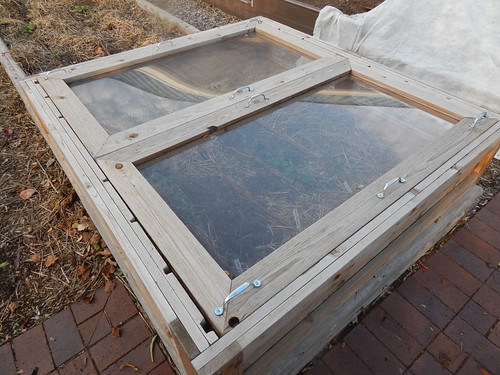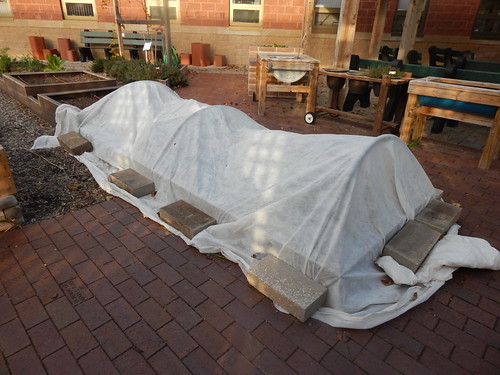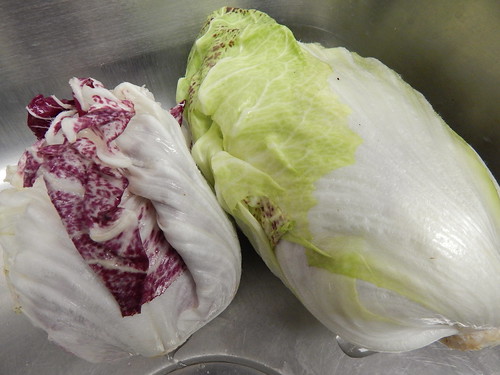Category Archives: Oh, the Weather
First Day of Summer Garden Update
It’s the first day of summer, and it feels like it! Like many of you, there are good and bad things happening in the garden due to the excessive rain and milder temperatures. Honestly…we kind of need this heat to push along some of our warm season plants.
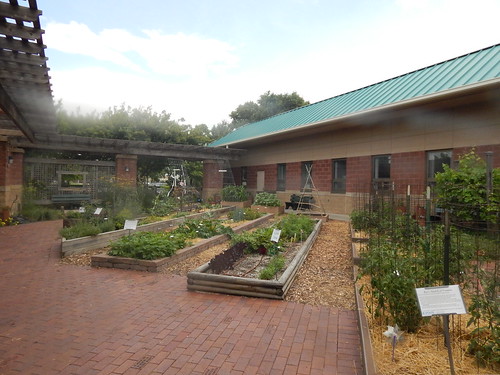 It has been awhile since an update, but that doesn’t mean we have been MIA in that garden. As you can see, despite the weather challenges, the garden is planted, we have been harvesting, and things are going well. One benefit of the raised beds (and the drainage tiles underneath our garden!) is that no matter how much rain we have gotten, it drains away fairly quickly. So we are not seeing too much root damage from saturated soils.
It has been awhile since an update, but that doesn’t mean we have been MIA in that garden. As you can see, despite the weather challenges, the garden is planted, we have been harvesting, and things are going well. One benefit of the raised beds (and the drainage tiles underneath our garden!) is that no matter how much rain we have gotten, it drains away fairly quickly. So we are not seeing too much root damage from saturated soils.
The herbs & pollinators garden has been growing gangbusters, with absolutely huge bronze fennel, lush parsley, and several beautiful agastaches.
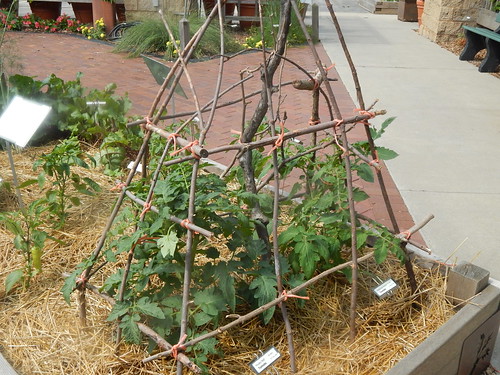 We once again have a SNAP-Ed garden, where we are highlighting the ability to use SNAP dollars to purchase garden plants. We track our expenses and the value of harvested crops. We also have to budget for every purchase, so there is often not money to purchase tomato cages or similar items. The gardeners built this homemade tomato cage for the two tomato plants. We will see if it fares better than last year’s homemade cage!
We once again have a SNAP-Ed garden, where we are highlighting the ability to use SNAP dollars to purchase garden plants. We track our expenses and the value of harvested crops. We also have to budget for every purchase, so there is often not money to purchase tomato cages or similar items. The gardeners built this homemade tomato cage for the two tomato plants. We will see if it fares better than last year’s homemade cage!
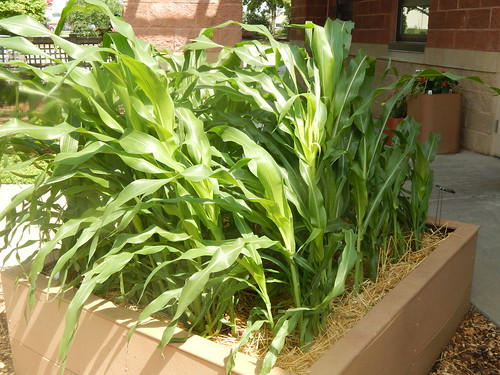 Corn is something new for us in the Demo Garden, simple because of the space requirements. We tried a Peruvian corn variety a couple years ago, but it didn’t grow. This corn is ‘Glass Gem’ popcorn. We are interested to see how it performs in the small area we have given it.
Corn is something new for us in the Demo Garden, simple because of the space requirements. We tried a Peruvian corn variety a couple years ago, but it didn’t grow. This corn is ‘Glass Gem’ popcorn. We are interested to see how it performs in the small area we have given it.
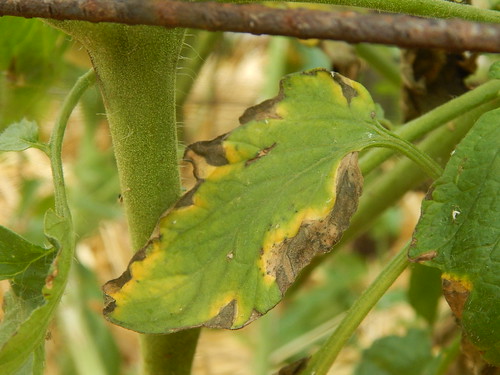 Lest you think all is well in the garden, we are starting to see a fair amount of early blight on the lower tomato leaves. We hadn’t mulched the garden until last week, which probably didn’t help prevent disease. Mostly this is a rain and humidity problem. Cultural controls would include mulching, caging or staking, and keeping the leaves dry. Fungicide options would include chlorothalonil and copper-based products. It is important to note that fungicides only prevent new leaves from becoming infected, NOT cure infected leaves.
Lest you think all is well in the garden, we are starting to see a fair amount of early blight on the lower tomato leaves. We hadn’t mulched the garden until last week, which probably didn’t help prevent disease. Mostly this is a rain and humidity problem. Cultural controls would include mulching, caging or staking, and keeping the leaves dry. Fungicide options would include chlorothalonil and copper-based products. It is important to note that fungicides only prevent new leaves from becoming infected, NOT cure infected leaves.
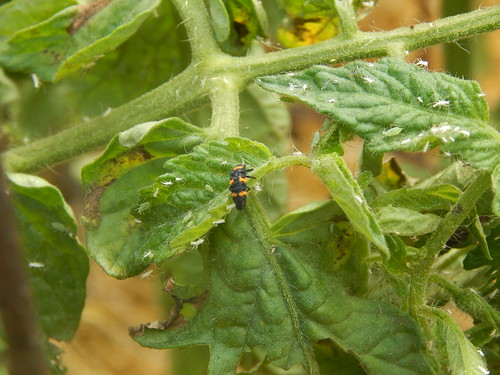 The other thing that we are seeing right now are aphids all over the tomatoes. This is quite abnormal, but probably due to the cooler weather. The benefit of hotter weather is that it should help the tomatoes grow faster and slow down the aphids (which normally like cooler weather). The white specks are the molted husks of the aphids. The black and orange guy is a ladybug larvae that is happily feeding on the aphids. We are hoping that between the hotter weather and the ladybugs, we won’t need to treat for the aphids.
The other thing that we are seeing right now are aphids all over the tomatoes. This is quite abnormal, but probably due to the cooler weather. The benefit of hotter weather is that it should help the tomatoes grow faster and slow down the aphids (which normally like cooler weather). The white specks are the molted husks of the aphids. The black and orange guy is a ladybug larvae that is happily feeding on the aphids. We are hoping that between the hotter weather and the ladybugs, we won’t need to treat for the aphids.
There is much more to see in our garden, so come on over at visit us sometime!
Flooded Gardens
If your garden flooded during the rainfall last week, your produce may not be safe to eat!
After flooding has occurred, the best way to ensure that your produce is safe is to not consume any of it. However, it can be very difficult to throw away a lot of produce that still looks okay.
- If your garden was flooded by rainwater that just didn’t soak in as fast due to the amount of rain, most of the produce is probably safe, if you are sure there were no likely contaminants in the area (fecal matter, industrial chemicals, etc).
- If your garden was flooded by water coming out of ditches, rivers, ponds, or other sources, you should assume that the produce is contaminated. All ripe produce should be harvested and discarded, especially anything normally consumed raw.
- For complete details on safety of produce after flooding, please refer to this fact sheet: Safely Using Produce from Flooded Gardens
Prepping for Fall & Beating the Heat
Many years, fall is my favorite time in the garden here in Kansas. The tricky thing is getting yourself into a “fall” mindset when it is still blazingly hot in early August. Yes, now is the time to plan, prepare, and plant your fall vegetable garden!
 We started seeds for some of our fall plantings about 4-5 weeks ago: broccoli, cauliflower, Japanese winter bunching onion, kale, and bok choy.
We started seeds for some of our fall plantings about 4-5 weeks ago: broccoli, cauliflower, Japanese winter bunching onion, kale, and bok choy.
I moved them outside onto the table near the building last week, so they don’t look quite this nice anymore. The flea beetles are going to do a number on our fall brassicas, I’m afraid.
Despite the heat, I wanted to get at least some of these plants in the ground, because they are drying out too fast in the cell trays.
Timing isn’t too critical on some of these, but the broccoli and cauliflower may not have a long enough growing season if we don’t plant them soon.
We also have a number or root vegetables that need to be planted soon if we want to get a good crop.
Things like lettuce and spinach need to wait a few more weeks, because the soil is just too warm to plant now. They also grow faster, so we can afford to wait a bit longer to plant.
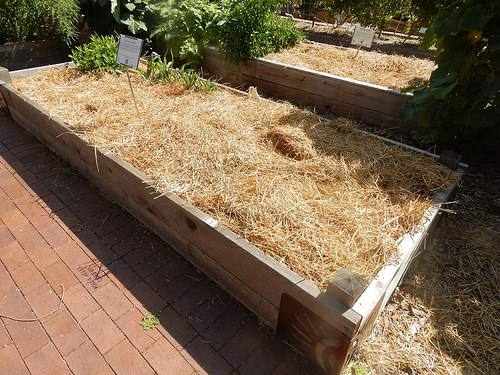
In preparation for planting some of our root vegetables next week, we put a thick layer of straw mulch down in some of the planting areas. Organic mulches like straw can cool the soil up to 10 degrees in addition to helping with soil moisture. Hopefully we’ll get better germination because of the straw.
For more ideas and techniques about fall vegetable gardens, here are several posts about fall gardening from a few years ago:
Fall Gardening: Why Try It and What to Plant
Fall Gardening: Less Common Vegetables for Kansas
Fall Gardening: Dealing with Late Summer Heat
Fall Gardening: Dealing with Late Fall Cold
Fall Gardening: Kansas Climate Conditions for Extending into the Winter
Cold, Wet, Wet, Cold… Strawberries!
I don’t know about you, but I feel like I live in Seattle or England, or someplace else that is reputed to be cold and rainy. While I’m not going to complain about the rain (too much), the colder than normal temperatures combined with the rain are causing some garden challenges that we are not used to seeing in Kansas. Namely, a lot of diseases and related problems that we aren’t used to! All those problems that are listed under the “caused by cool, wet conditions” we typically ignore. Well, not this year!
 Luckily for us, the Demo Garden has excellent drainage (we installed drains a few years ago) and raised beds to help keep the soil warmer and drier than would otherwise be the case. Even so, we were still having issues with the beans due to cold soils. I’m curious to see how the squash does, particularly some of the heirlooms.
Luckily for us, the Demo Garden has excellent drainage (we installed drains a few years ago) and raised beds to help keep the soil warmer and drier than would otherwise be the case. Even so, we were still having issues with the beans due to cold soils. I’m curious to see how the squash does, particularly some of the heirlooms.
 Of course, the lettuces and greens are perfectly happy with the weather. I’ve noticed some slugs and roly polys enjoying my lettuce at home, because they love the moisture. If you are seeing slugs or roly polys, the best thing to do is to improve the air circulation around your plants. In my case, I was seeing the problem in lettuce that I hadn’t yet gotten thinned out. The areas where the plants were not too thick were unaffected. Roly polys love decaying organic matter, so removing any damaged, diseased, or dying leaves is also important.
Of course, the lettuces and greens are perfectly happy with the weather. I’ve noticed some slugs and roly polys enjoying my lettuce at home, because they love the moisture. If you are seeing slugs or roly polys, the best thing to do is to improve the air circulation around your plants. In my case, I was seeing the problem in lettuce that I hadn’t yet gotten thinned out. The areas where the plants were not too thick were unaffected. Roly polys love decaying organic matter, so removing any damaged, diseased, or dying leaves is also important.
As I was belatedly thinning out my lettuce, I also noticed some leaves with disease lesions on them. Also due to cold, wet, and poor air movement.
Our Hotline has been taking lots of calls about fungus, including instances of potato plants rotting off. Cold, wet, poor drainage are the culprits. In this case, there’s not much to do now, other than do what you can to improve air circulation and drainage. We haven’t seen a problem in the demo garden since the potatoes are in a tall raised bed.
 The new strawberries are happily filling in rapidly with the mild weather. The older plants are still producing some berries. Fruiting strawberries can be quite negatively affected by cold, wet weather. At home, I’ve observed slugs and roly polys eating fruit, as well as numerous berries with rotting fruit due to the wetness. Again, the keys are keeping the fruit as clean and dry as possible. I don’t have a good straw layer down, which is resulting in berries sitting on dead leaves – not good! The weather has resulted in me doing something that I almost NEVER do – pick fruit before it is 100% ripe. I’m sacrificing the best flavor for not damaged berries, which I’m willing to do under the circumstances. It’s also important to pick and remove any berries showing damage, because the rain will just keep spreading the fungal spores to the remaining fruit and the problem gets worse.
The new strawberries are happily filling in rapidly with the mild weather. The older plants are still producing some berries. Fruiting strawberries can be quite negatively affected by cold, wet weather. At home, I’ve observed slugs and roly polys eating fruit, as well as numerous berries with rotting fruit due to the wetness. Again, the keys are keeping the fruit as clean and dry as possible. I don’t have a good straw layer down, which is resulting in berries sitting on dead leaves – not good! The weather has resulted in me doing something that I almost NEVER do – pick fruit before it is 100% ripe. I’m sacrificing the best flavor for not damaged berries, which I’m willing to do under the circumstances. It’s also important to pick and remove any berries showing damage, because the rain will just keep spreading the fungal spores to the remaining fruit and the problem gets worse.
![20150520_153436[1]](https://thedemogardenblog.files.wordpress.com/2015/05/20150520_1534361.jpg?w=604&h=340) The last problem that we can expect from the rain and cold is root damage. You can see this strawberry plant has some black and brown roots that have been damaged by the excess moisture. While we probably won’t see much sign of root damage until the rain stops, it’s likely to be a problem. I can already tell you that my basil at home isn’t going to make it. Signs of root damage include yellowing leaves, leaf curl/wilting (especially when the soil is still moist), and stunted growth. With as much rain as we’ve had, I also won’t be surprised if we see some nitrogen deficiencies in areas with sandier soils.
The last problem that we can expect from the rain and cold is root damage. You can see this strawberry plant has some black and brown roots that have been damaged by the excess moisture. While we probably won’t see much sign of root damage until the rain stops, it’s likely to be a problem. I can already tell you that my basil at home isn’t going to make it. Signs of root damage include yellowing leaves, leaf curl/wilting (especially when the soil is still moist), and stunted growth. With as much rain as we’ve had, I also won’t be surprised if we see some nitrogen deficiencies in areas with sandier soils.
Well…except that we needed the rain, this post has been as gloomy as the weather! But it’s not all bad:
Preparing for the Sudden Onslaught of Winter
I feel like I spend a lot of time on this blog talking about the weather, but it really isn’t just idle conversation! The weather is extremely important to our success as gardeners. After one light freeze and lots of unseasonably warm weather, we are looking at more than a week of unseasonably cold temperatures. Overnight lows look like they will be hovering in the upper teens to low 20s for the better part of the next two weeks. (At least that low of 9 degrees is gone, for now!) Many of the cool season vegetables will tolerate temperatures down to 24 or 25 without significant damage, but two weeks of lows down around 20 is probably a bit much for them to tolerate, especially when they haven’t been hardened off with cold-but-not-too-cold temperatures.
So…it was time to harvest some things and cover others this afternoon! Because I can’t resist experimenting, I left one or two plants of almost everything in the garden, just to see what would happen.
We already had the cold frame out, but still open. We closed it up and tucked some straw along the back edge to keep the cold air out.
We also put hoops and row cover over the main section of spinach and radicchio. Normally I’d leave those out, but I think this will be a bit cold all of a sudden.
I left some of the other spinach around the garden uncovered, including the Indian variety. (I don’t have great hopes for its cold hardiness!)
I harvested a few of the radicchio plants to see what stage they were at. I also harvested the watermelon radishes, fennel, half the bunching onions, and most of the dandelion greens. I was just going to leave the lemongrass, but then I just couldn’t let it go to waste, so it went to our Foods & Nutrition department.
I’ll post more pictures and show what I did with some of the different vegetables later in the week!


